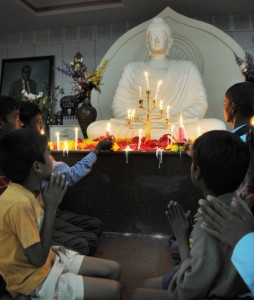Return To Which Home?

Dalits worshipping the buffalo before participating in a conversion ceremony at Balmiki Ashram on the occasion of the 112th birth anniversary of Ambedkar, in Chandigarh in April 2003. The converts, mostly scavengers, vowed to worship the buffalo instead of the cow. Photo:PTI
On October 14, 1956, Babasaheb Ambedkar, along with several hundred thousand “untouchables”, embraced Buddhism. The moral and ethical strength of Ambedkar’s embrace of Buddhism lies in its cultural and intellectual capacity to sustain among the ex-untouchables a growing association with it. Conversion as a cultural-intellectual movement that took off in October 1956 from Nagpur continues to gain strength. It would be fair to observe that Ambedkar’s Buddhism has got a pan-Indian following among certain castes formerly deemed untouchable, such as the Jatava/Chamar from Uttar Pradesh and Punjab, the Malas from Andhra Pradesh, the Parayars from Tamil Nadu, the Adi Karnataka from Karnataka, and a tiny section of Pulayas from Kerala and of course the Mahars and a few Matangs from Maharashtra.
However, scholars of Buddhism have perceived different meanings in Ambedkar’s conversion. Some of them locate the primacy of nationalism in the act, while others see it as a decision emerging from Ambedkar’s frustration with Hinduism. Still others see the conversion as a personal choice that Ambedkar imposed on millions of untouchables. Arguably, such multiple readings of Ambedkar’s conversion, by default, treat Hinduism as the least important factor in Ambedkar’s act of conversion to Buddhism. By Ambedkar’s own admission, it is Brahmanical Hinduism that provided the major context for the emergence of Buddhist assertion starting from Iyothi Thass and Laxmi Narsu from Tamil Nadu, culminating in Ambedkar’s 1956 conversion. Ambedkar held Brahminical Hinduism largely responsible for producing what could be called the withering down impact, particularly on untouchables.
His decision to embrace Buddhism, however, involves two mutually exclusive principles of responsibility, negative and positive. Taking a cue from Aristotle, one could argue that Ambedkar’s conversion was driven by the moral force of positive responsibility, which the protagonists of Hinduism refuse to accept. Ambedkar expected Hindu leaders to take the lead in terms of first critically reflecting on the regressive character of Hinduism and subsequently acknowledging it through a honest conversation with untouchables. He expected the defenders of Hinduism to accept the untouchable’s critique of Hinduism. He also expected them to make honest efforts to take the liberal principle seriously and do it by producing an Indian Voltaire who could then introduce radical alteration into the very structure of Hinduism which is the caste system.
But as the social history of anti-caste struggles show, Brahmanism defeated the Buddha and also failed to produce a Voltaire. The lack of liberalism among orthodox Hindu leaders was evident in their refusal to listen to Ambedkar on the question of annihilation of caste at Lahore and in their fierce resistance to Dalits’ right to draw water at the Chawdar tank in Mahad and to Dalits’ right to enter temples in Nashik and Pune. Upper-caste Hindus not only not supported such rights but also violently opposed Ambedkar leading the struggle for Dalits’ human rights. In view of this collapse of his efforts to reason with Hindus, Ambedkar had to fix negative responsibility on them.
The principle of negative responsibility holds an individual or a social group or an entire society responsible for the act which is likely to go against the interests of the holders of a particular faith. In this view, Hinduism is held responsible for giving rise to Ambedkar’s neo-Buddhism. Before declaring that he would not die as a Hindu, at Yeola town in Nashik district, Ambedkar invoked the principle of natural justice and invited Hindus to defend their case against the accusations that he was making.
His main charge against Hinduism was that its philosophy killed good common sense based on the principles of equality, justice, freedom and compassion. Convinced by the need for natural justice, Ambedkar gave orthodox Hindus a long rope so that they could first modify and then rectify their religious doctrines by seriously questioning their religion. In conclusion, one may say that Ambedkar’s conversion did not sprout from the tabula rasa, or a clean slate. The rigid nature of Hinduism provided the formative context for Ambedkar to justify his decision.
Positive responsibility
The principle of positive responsibility is internal to the moral and ethical act of offering justification. Justification becomes morally defensible and hence universally valid to the extent that it is based on the stronger claim for a superior cultural alternative that would work out in the interest of the collective good. Neo-Buddhism, through its arya astngangik marg (eight fold ethical path), promises to offer ethical care for both the “touchables” and untouchables in India.
Ambedkar saw in Buddhism the best alternative to establish perpetual peace, at least in India. The expression of this normative need was evident in his declarative statement (in Marathi): “Sara Bharat Buddhamay Karin” ( I will expect every Indian to become Buddhist). Ambedkar, thus, argued that neo-Buddhism was a superior alternative to other religions on the following grounds. First, his conversion was aimed at creating independent moral standards by which every human being and not just the untouchables would evaluate their social worth. This moral evaluation would be independent of Brahmins who were traditionally placed at the top of a scale of ritual hierarchy so that they could be imitated by the rest of society. Ambedkar argued that Hinduism sought to convert the real into the ideal, which then is available for imitation by those social layers which have developed the sense of cultural aspiration to catch up with the socially superior. Everybody would like to associate with higher castes through the process of Sanskritisation. It is pathological in the sense that a “lower”-caste person can never become a Brahmin and enjoy the social power that emanates from the ritual status of being a Brahmin.
Second, Ambedkar’s decision to convert did not spring from a tabula rasa. Nor was it a hypothetical proposition or a transcendental judgment that was the guiding force of the decision. Neo-Buddhism as envisioned by Ambedkar had a very strong subaltern character. The early followers of Buddhism were the poor masses. Buddhism could flourish with subaltern commitment rather than state patronage. Third, Ambedkar’s conversion was not the result of any empty fascination for an abstract philosophical persuasion, and nor was it the result of any frustration. On the contrary, it has to be understood primarily in terms of its cultural and political force. The theory of “Karma”, which continues to work as a strong basis of Brahmanical Hinduism, was responsible for casting untouchables into a role defined by fate. The concept of “fate” seeks to naturalise the degrading and humiliating social conditions that virtually produce social death for untouchables.

Boys in prayer before a Buddha image at a conversion programme orgainsed by the Karnataka Dalitha Sangharsha Samiti at Ambedkar Bhavan in Bangalore in October 2008. Photo:The Hindu Archives
The logic of fate seeks to paralyse a person’s faith in his own agency. Ambedkar’s act of conversion was meant to enable untouchables to step out from the mental prison of “fate” and walk into a more dynamic sphere of freedom. An untouchable saint from 13th century Maharashtra adopted the mindset reflected in these words: “Thewile anante taisechi rahawe” (the human being is destined to live life as ordained by god). Ambedkar’s effort to wean untouchables away from this mindset was evident in one of the meetings that was held by the saints in Mumbai during the anti-caste struggle in the 1930s.
In this meeting Dalit saints endorsed Ambedka’s decision to leave Hinduism. In this regard, it is also important to keep in mind that some of followers of the saint and the warkari tradition from 19th century Maharashtra showed an undeclared inclination for Buddhism. This is why Krishnaji Arjun Keluskar, a warkari, gifted a copy of the biography of Buddha to Ambedkar, who was a student of Keluskar in his high school days.
Fourth, Ambedkar’s conversion shifted focus from everyday forms of maintaining the ritual purity of the body, which continues to be the core of orthodox Hinduism even today, to the creative life of the mind that is internal to neo-Buddhism. Its principle of “atta dippo bahva” promised fulfilment of at least two basic subjective needs—self-definition and intellectual self-determination. As an act of intellectual self-determination, Ambedkar’s conversion sought to demystify the negatively imposed identity of being a part of Hinduism. Ambedkar’s justification also embodied a moral element of the care of the other—the high-caste Hindus caught in the historical cycle of of domination and subordination needed emancipation. Ambedkar could have argued that he did not have to justify his conversion. But he felt the acute need for a justification that would highlight the main teachings of the faith he was embracing—equality, dignity and friendship.
“Ghar wapsi”
In the context of Ambedkar’s conversion, in the course of which he appealed even to upper-caste Hindus to think of Buddhism as a possible alternative, how does one perceive the stated Hindutva objective of making India Hindu? How does one look at the call for “ghar wapsi”?
The “ghar wapsi” programme promises a return to a place that was never “home” in the first place. Untouchables were never considered an organic part of Hinduism, and, as Ambedkar said, they were outside the Hindu fold. The defenders of Hinduism must be asked whether they are talking about accommodating Dalit in a ghar (home) that exists only in abstraction or are they ready to integrate Dalits into the Brahmin ali (which in Marathi means a Brahmin residential neighbourhood) at the concrete level?
A few questions
What meaning does “ghar wapsi” hold for the Arya Samajists who were seeking Suddhi during the freedom struggle? Or for the different Hindutva outfits working towards the project of making India a Hindu nation? What is its relevance for those broken men and women who were so long kept outside the “ghar”? Secondly, “ghar wapsi” makes sense only in regard to the lower-caste convert. The upper-caste men and women who converted to Sikhism, Islam and Christianity arguably do not constitute an appropriate case for “ghar wapsi”. They enjoy the same power of social domination as the upper-caste Hindus do. This seamlessness eliminates the need for “ghar wapsi”.
Ambedkar would expect the contemporary defenders of Hinduism to offer justification as to why Dalits should return to the Hindu fold. Where will the champions of “ghar wapsi” put the untouchables-in the Brahmin ali or agrahara (in Tamil) or tola (in north India)? How can they accommodate the untouchables in the agrahara without a radical reconfiguration of Hinduism on egalitarian lines? Can they achieve this without destroying the painful system of social hierarchy that forms the basis of Hinduism? They do not have any plan to seek this radical inversion of Hinduism. It is for this reason that Ambedkar considered Buddhism the superior option for untouchables.
Gopal Guru is a professor at the Centre for Political Studies, Jawaharlal Nehru University. He has authored two books with Oxford University Press, Humiliation: Claims and Context and The Cracked Mirror: An Indian Debate on Experience and Theory.
[Courtesy: Frontline, January 9, 2015]






















Connect
Connect with us on the following social media platforms.